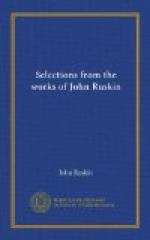Of the main facts of this tale there is no doubt. They were embellished afterwards, as usual, by many fanciful traditions; as, for instance, that, when the sarcophagus was discovered, St. Mark extended his hand out of it, with a gold ring on one of the fingers, which he permitted a noble of the Dolfin family to remove; and a quaint and delightful story was further invented of this ring, which I shall not repeat here, as it is now as well known as any tale of the Arabian Nights. But the fast and the discovery of the coffin, by whatever means effected, are facts; and they are recorded in one of the best-preserved mosaics of the north[152] transept, executed very certainly not long after the event had taken place, closely resembling in its treatment that of the Bayeux tapestry, and showing, in a conventional manner, the interior of the church, as it then was, filled by the people, first in prayer, then in thanksgiving, the pillar standing open before them, and the Doge, in the midst of them, distinguished by his crimson bonnet embroidered with gold, but more unmistakably by the inscription “Dux” over his head, as uniformly is the case in the Bayeux tapestry, and most other pictorial works of the period. The church is, of course, rudely represented, and the two upper stories of it reduced to a small scale in order to form a background to the figures; one of those bold pieces of picture history which we in our pride of perspective, and a thousand things besides, never dare attempt. We should have put in a column or two, of the real or perspective size, and subdued it into a vague background: the old workman crushed the church together that he might get it all in, up to the cupolas; and has, therefore, left us some useful notes of its ancient form, though any one who is familiar with the method of drawing employed at the period will not push the evidence too far. The two pulpits are there, however, as they are at this day, and the fringe of mosaic flowerwork which then encompassed the whole church, but which modern restorers have destroyed, all but one fragment still left in the south aisle. There is no attempt to represent the other mosaics on the roof, the scale being too small to admit of their being represented with any success; but some at least of those mosaics had been executed at that period, and their absence in the representation of the entire church is especially to be observed, in order to show that we must not trust to any negative evidence in such works. M. Lazari has rashly concluded that the central archivolt of St. Mark’s must be posterior to the year 1205, because it does not appear in the representation of the exterior of the church over the northern door;[153] but he justly observes that this mosaic (which is the other piece of evidence we possess respecting the ancient form of the building) cannot itself be earlier than 1205, since it represents the bronze horses which were brought from Constantinople in that year.




